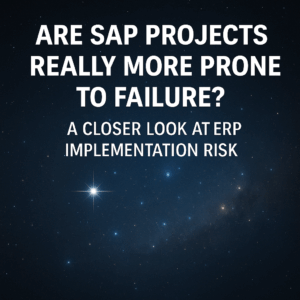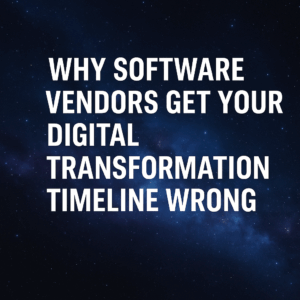Digital transformations are high-risk endeavors with some common failure points that often lead to failures. But what exactly are those failure points, and how can you avoid them? That’s what we want to talk about in today’s article.
During any sort of project or change initiative, digital transformations face a number of risks. There are some common patterns and threads that lead to failure, as well as some that lead to success. Therefore, today, I want to discuss the top 10 points of failure or causes of failure that you need to avoid before you embark on a digital transformation journey.

Table of Contents
TogglePoor Project Management
Number ten on our list is poor project management. If you don’t have the right project governance controls and overall project management in place, it’s easy to lose track of your scope, go over budget, slip timelines, and lack accountability for project success. Not having good project management and program governance can result in a whole host of different symptoms. To avoid this risk, you can leverage your internal PMO to set up a strong project governance and management framework.
Alternatively, if you lack this competency in-house, make sure to leverage outside help, ideally independent third-party help, to guide you through the project management and governance work stream. However, be wary of deferring to your systems integrator or software vendor for program management, as they only address one work stream within the project. Make sure to have a project management program governance framework in place to avoid this risk on digital transformations.

Poor Risk Mitigation
Number nine on our list is poor risk mitigation, which is similar to the previous point about project management and project governance, but technically different. It is part of program governance and involves identifying and proactively addressing risks before they become significant problems that are hard to overcome. Most risks and problems during digital transformations do not happen overnight; they tend to percolate and bubble underneath the surface until they become a big problem that is challenging to reverse. To address this, you need skilled outside resources who can identify the risks, recognize mistakes you may be making without realizing it, and help you mitigate and get ahead of those risks before it’s too late.
As per McKinsey, 70% of the digital transformation fail.
Lack of Project Planning
Coming in at number eight on our list is a lack of project planning and implementation readiness. The reason this is such a big problem is that organizations tend to get really excited when they’ve defined a new roadmap, picked new technology, identified who their partners are going to be, and are ready to start building and deploying. However, without having a clear vision of what you are going to accomplish, how you’re going to get there, what your business processes are going to be, and how you’re going to manage the organizational changes, if you haven’t addressed these and other aspects of your implementation early on, you’re just going to start spinning your wheels and spending a lot of time and money on wasted efforts that you’re going to have to rework later.
Therefore, by taking the time upfront to make sure that you have a solid project plan and implementation phase zero, that’s going to allow you to take the time to make sure you have a solid blueprint and architecture for what this digital transformation is going to look like, how you’re going to manage it, how all the different parties involved in the project are going to contribute to it, and ultimately help you be more successful and have more accountability and ownership for the overall digital transformation.
Deferring to Technology
Number seven on our list is deferring too much to technology. It could be that you’re deferring to one single ERP system to solve all of your problems and be that silver bullet to address your needs, or it could be that you have multiple technologies you’re trying to deploy and you’re going to leverage those technologies to identify what business processes you’re going to deploy as an organization. Now, there’s some truth and merit to this. You do want to leverage the capabilities, competencies, and workflows inherent in the technology primarily so you don’t have to customize the technology, but you also don’t want to defer so much to the technology that you have no vision and no clarity of what it is you want the software to accomplish for you.
One reason this is so important is that today’s modern enterprise technology is so flexible when you compare it to 10 or 20 years ago that you have a multitude of different options and decisions that need to be made just to deploy the technology the way it was built. Therefore, if you don’t have a clear vision of what it is you want to get out of the technology and you’re just assuming that the technology is going to tell you how to run your business, what’ll end up happening is one of two things.
One is you’re going to be paying by the hour for consulting resources to wait for you to make your decision on how you want to run your business or, worse yet, the outside third parties, the consultants, or the software vendors will decide for you how you’re going to run your business, whether or not it fits your longer-term objectives or not. So the key here is to make sure that you have a clear vision of what you want to be when you grow up, which goes back to the previous point about having that solid project plan in the implementation readiness phase, the phase zero of your project. This is one of those activities that you need to address in that phase to mitigate this risk.
Dependence on Technical Implementers
Another challenge and risk that digital transformation teams often face is an over dependence on the technical implementers. Whether it be the value-added reseller, the software vendor themselves, or a system integrator, deferring too much to them and assuming that they’re going to run the project for you means you’re missing out on a lot of things. First of all, you’re missing out on the scope of what needs to happen to make your project successful outside the realm of technology.
Systems integrators and software vendors are good at building technology and deploying technology, but they’re generally not good at deploying organizational changes, process improvements, project governance, and risk mitigation, as well as overall architecture and integration. Those are things that need to be addressed by someone else other than the technical implementer. So the key here is to recognize that the technical implementer plays an important role in your digital transformation, but if you defer too much to them or solely to those parties, you’ll miss out on all the things that will ultimately make your project successful or more of a failure.
Absorbing Too Much Risk
The next risk to be aware of and to mitigate with your digital transformation is the phenomenon of absorbing too much risk in too little time within your organization. Think about all the capabilities and the new functionality that software vendors are creating every day, and these oftentimes are light-years ahead of where most organizations are, and they’re only accelerating the pace of change in these technological capabilities. The problem is most organizations can’t keep up with that pace of change. You may aspire to be more nimble, more agile, and adapt to change more quickly, but for most organizations, they’re stuck with inertia, and they’re stuck moving slowly as they have in the past.
While they’ll try to change that during a transformation, oftentimes what happens is organizations will bite off more than they can chew during their digital transformation. They’ll buy too many software modules or too many different technologies that they’re not ready for or that they simply can’t absorb in the time frame they’ve defined for their digital transformation.
So the key here is to be self-aware and understand where you are as an organization and how quickly you can realistically change. It’s always a bit easier to speed up if you find that you’re absorbing the change quicker than you thought, which, by the way, is extremely rare. We don’t meet many clients, if any, that ever say that. But let’s just say worst-case scenario, you find that you’re changing faster and you’re absorbing the changes faster than you thought you could. It’s always easier to speed that up than to try and take on and bite off more than you can chew and just setting yourself up for failure. So one of the keys is to be very deliberate about how much change you’re willing to take and when you’re willing to make those changes.
Unrealistic Expectations
The next risk to be aware of is unrealistic expectations. Too many organizations go into a transformation thinking that they can deploy technology in 18 months. When, in fact and in reality, they were never going to deploy those changes in 18 months. It was always going to be more like three years. This is not because they didn’t manage the project successfully or because the project wasn’t effective, but because most organizations have trouble changing, as I mentioned earlier, and absorbing change within an organization. So when you have unrealistic expectations about how long a transformation will take, and/or how much time and money it’s going to take, what ends up happening is that you end up cutting corners later on when you realize finally that you have banked on these unrealistic expectations.
You find that you’re behind schedule, or you’re going over budget. If you’re trending outside the parameters of the plan you have in place, you end up cutting corners. You start to cut things like change management, training, and a couple of cycles from conference room pilots. You don’t integrate those systems that are core and critical to your business. You start to make bad decisions, not because you want to, but because you have to, and you’re boxed into a corner.
This is because you’ve drawn a line in the sand for an unrealistic timeline and/or an unrealistic budget. So the key here is to be realistic. Go in with your eyes wide open. Understand what exactly this transformation entails, and also understand realistically how quickly you, as an organization, can change, and how realistically you can deploy different types of technologies and process changes.
Poor Change Management
Number three on our list of digital transformation risks is poor change management. In other words, you don’t manage the organizational changes that are happening as a result of your digital transformation, or you don’t do so effectively. Oftentimes, what happens is that organizations think that by doing some training for end-users shortly before go-live, doing some newsletters and emails prior to go-live will be enough to get people ready for change and to get them comfortable with the change. But the reality is that’s only scratching the surface. You really need to do a lot of leg work prior to any of that stuff happening on the training communication side. You need to do things like organizational design to define how people’s jobs are going to change, how the roles and responsibilities are going to change.
There’s also change impacts, understanding how different people within the organization, different workgroups, and different business units are going to be impacted by the changes entailed by this transformation. Another example is the organizational readiness assessment, really quantitatively and qualitatively measuring how ready the organization is for change and adjusting to and defining a change management strategy that addresses those organizational readiness results.
So these are just a few examples of the things that need to be packed into your organizational change strategy, but the key here is to recognize that most organizations we work with, if not all of them, find that change management is more difficult than they ever thought it would be. So if you go in with that expectation and take the time upfront, early on to define your change strategy based on your needs, your culture, and where you’re headed as an organization, that’s going to make it more likely that you address this important critical success factor for a digital transformation.
Lack of Internal Alignment
The second biggest risk that we see with organizations going through digital transformations is a lack of internal alignment. In other words, we are not all on the same page. We are not rowing in the same direction. We are doing our own thing, going in different directions, or we have different visions of what this project should be and what this transformation should entail for our organization. We have to get on the same page. It’s normal to have some level of misalignment, but we have to get on the same page before we start the transformation.
Otherwise, we’re going to be spinning our wheels, wasting a lot of time, money, and morale to try and get on the same page. If we can spend the time upfront getting on the same page and having clarity around what it is we want to get out of this project, how we define success, and what some of the key parameters and decisions are for the transformation, that’s just going to make things a lot easier later on.
So one way to look at this or think about it is if we take one step back, that’s going to allow us to take two steps forward in the future. Rather than just rushing into the transformation when we have misalignment, and instead focusing on really addressing that misalignment, the core root cause of that misalignment, that’ll help us speed things up later on. That’ll actually make our transformation go faster and cheaper than it would be otherwise.
Lack of Strategic Clarity
The single most important risk and the most damaging risk that organizations face when going through digital transformation is a lack of strategic clarity. They don’t have a clear sense of what it is they want to get out of this transformation. They haven’t defined how this digital transformation supports their larger, more strategic, longer-term goals and objectives. And they certainly haven’t made some of the key decisions that need to be made to set the parameters and guard rails for the transformation.
So one of the first things we do when working with clients, in addition to helping select the right technology for them, is to also, as part of their implementation upfront, define what it is they want to get out of this project, what are the strategic goals and objectives for this project, and how does that translate into specific parameters, criteria, and guidelines for the transformation and the overall digital strategy.
Instead, what typically happens is software vendors come in with their one-size-fits-all proposed project plan that doesn’t align with what it is you’re trying to accomplish strategically. So this process of reconciliation between your strategic goals and objectives and what your software vendor and your system integrators have proposed is a really important activity that will create a lot of tailwinds later on, rather than causing you to face headwinds.
So the number one thing you could do if you had to pick one thing on this list is to make sure that you have strategic clarity and articulation of where it is you’re headed and how this transformation will help you achieve those goals. These are the top 10 biggest risks that you should be aware of in any digital transformation.
If you are looking to strategize an upcoming transformation or are looking at selecting an ERP system, we would love to give you some insights. Please contact me for more information eric.kimberling@thirdstage-consulting.com





